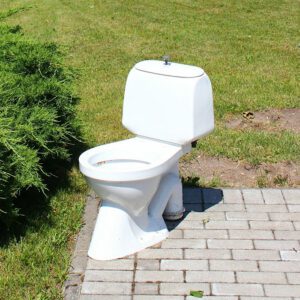It doesn’t feel reassuring to see a real estate listing advertising a 1.5 bath condo, and then see in the property details that there are “1.1 bathrooms.” This is frequently confusing for buyers, and is something real estate agents have to clarify for their clients on a regular basis. Clients might wonder if the .1 bathroom is a single hole in the ground, or just a water hose in an empty room. This confusion is understandable, as “.1 bathrooms” seems like either a typo, or someone describing a bucket of water as a “spa.”
 This apparent conflict between the listing details and the general description of bathrooms is actually much less deceptive than it seems. According to the Uniform Appraisal Dataset, “.1” bathrooms actually means one half-bath. The Uniform Appraisal Dataset, or UAD, is a set of appraisal standards developed after the 2008 housing market crash to make appraisals more consistent and easy to compare.
This apparent conflict between the listing details and the general description of bathrooms is actually much less deceptive than it seems. According to the Uniform Appraisal Dataset, “.1” bathrooms actually means one half-bath. The Uniform Appraisal Dataset, or UAD, is a set of appraisal standards developed after the 2008 housing market crash to make appraisals more consistent and easy to compare.
One aspect of the UAD is clear reporting on the number of bathrooms in each appraised home. On first glance, “1.5 baths” seems to make more sense than “1.1 baths.” However, if a home has 2 bathrooms and 2 half-baths, does the home have a total of 3 bathrooms, since 2 + 1/2 + 1/2 = 3? If there’s no uniform way to describe this bathroom situation, some might say this home has 3 baths, and some might say it has 2 baths and 2 half-baths. The problem is that two half-baths do not equal one whole bathroom, since a full bathroom involves a shower or bathtub. If a home had only two half-baths and no other restrooms, it would have no place to shower. Thus, saying a home with two half-baths has one whole bathroom would be highly misleading.
To clarify this issue, the Uniform Appraisal Dataset specifies that the first number is the total number of full bathrooms, and the number after the decimal is the total number of half-baths. Thus, 1.2 bathrooms would be 1 full bath and 2 half-baths. By the same logic, 3.4 bathrooms will be 3 full bathrooms and 4 half-baths. I would be highly suspicious of a studio condominium that listed zero bedrooms and “.8 baths,” since this would be a unit with zero bedrooms and eight half-bathrooms.
This method of bathroom description actually has a huge impact on the mortgage market. Since property values secure trillions of dollars in loans, the appraisals of those property values must be consistent and comparable, and the number of bedrooms and bathrooms makes a massive difference in a home’s value. As odd as it sounds, the description of your bathroom is a vital part of the nation’s financial markets and their stability.
Of course, it wasn’t just weird bathroom descriptions that crashed the housing market (and everything else) in 2008, but it was part of a larger problem. The Federal Housing Finance Agency states that pre-2008 home appraisals had “poor data quality… inflated or fraudulent valuations, and a lack of appraiser independence from the lender.” In order to make appraisals more uniform, objective, and accurate, the government (through Fannie Mae and Freddie Mac) created the Uniform Appraisal Dataset. These appraisal standards were adopted in 2011, though they are still in constant development.
The majority of home shoppers have likely never heard of the Uniform Appraisal Dataset, and are understandably alarmed at a .1 or 1/10th bathroom. This is why the longer, main property description will usually say “1.5 baths” or “3.5 baths,” so that the average home shopper will instinctively understand the restroom situation. However, remember that “1.5 baths” technically means one full bathroom and five half-bathrooms, according to the UAD. There’s no cause for alarm if you see this in the main property description, but it should be concerning if the property details of a small condo say “1.5 baths.” If your buyer wants the majority of their square footage to consist of bathrooms, then an 800 square foot condo with five half-baths and one full bath will be the perfect fit.
Sources:
Uniform Appraisal Dataset Specification, Appendix D: Field-Specific Standardization Requirements, Fannie Mae and Freddie Mac, February 3, 2022.
https://singlefamily.fanniemae.com/media/21731/display
Request for Information on Appraisal-Related Policies, Practices, and Processes, Federal Housing Finance Agency, December 28, 2020.


